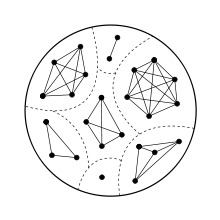Equivalence class
In mathematics, when the elements of some set S have a notion of equivalence (formalized as an equivalence relation) defined on them, then one may naturally split the set S into equivalence classes. These equivalence classes are constructed so that elements a and b belong to the same equivalence class if and only if they are equivalent.

Formally, given a set S and an equivalence relation ~ on S, the equivalence class of an element a in S is the set
of elements which are equivalent to a. It may be proven from the defining properties of equivalence relations that the equivalence classes form a partition of S. This partition – the set of equivalence classes – is sometimes called the quotient set or the quotient space of S by ~ and is denoted by S / ~.
When the set S has some structure (such as a group operation or a topology) and the equivalence relation ~ is compatible with this structure, the quotient set often inherits a similar structure from its parent set. Examples include quotient spaces in linear algebra, quotient spaces in topology, quotient groups, homogeneous spaces, quotient rings, quotient monoids, and quotient categories.
Examples
- If X is the set of all cars, and ~ is the equivalence relation "has the same color as", then one particular equivalence class consists of all green cars. X/~ could be naturally identified with the set of all car colors.
- Let X be the set of all rectangles in a plane, and ~ the equivalence relation "has the same area as". For each positive real number A there will be an equivalence class of all the rectangles that have area A.[1]
- Consider the modulo 2 equivalence relation on the set of integers, ℤ, such that x ~ y if and only if their difference x − y is an even number. This relation gives rise to exactly two equivalence classes: One class consists of all even numbers, and the other class consists of all odd numbers. Using square brackets around one member of the class to denote an equivalence class under this relation, [7], [9], and [1] all represent the same element of ℤ/~.[2]
- Let X be the set of ordered pairs of integers (a,b) with b not zero, and define an equivalence relation ~ on X according to which (a,b) ~ (c,d) if and only if ad = bc. Then the equivalence class of the pair (a,b) can be identified with the rational number a/b, and this equivalence relation and its equivalence classes can be used to give a formal definition of the set of rational numbers.[3] The same construction can be generalized to the field of fractions of any integral domain.
- If X consists of all the lines in, say the Euclidean plane, and L ~ M means that L and M are parallel lines, then the set of lines that are parallel to each other form an equivalence class as long as a line is considered parallel to itself. In this situation, each equivalence class determines a point at infinity.
Notation and formal definition
An equivalence relation on a set X is a binary relation ~ on X satisfying the three properties:[4]
- a ~ a for all a in X (reflexivity),
- a ~ b implies b ~ a for all a and b in X (symmetry),
- if a ~ b and b ~ c then a ~ c for all a, b, and c in X (transitivity).
The equivalence class of an element a is denoted [a] or [a]~, and is defined as the set of elements that are related to a by ~. The word "class" in the term "equivalence class" does not refer to classes as defined in set theory, however equivalence classes do often turn out to be proper classes.
The set of all equivalence classes in X with respect to an equivalence relation R is denoted as X/R and called X modulo R (or the quotient set of X by R).[5] The surjective map from X onto X/R, which maps each element to its equivalence class, is called the canonical surjection or the canonical projection map.
When an element is chosen (often implicitly) in each equivalence class, this defines an injective map called a section. If this section is denoted by s, one has [s(c)] = c for every equivalence class c. The element s(c) is called a representative of c. Any element of a class may be chosen as a representative of the class, by choosing the section appropriately.
Sometimes, there is a section that is more "natural" than the other ones. In this case, the representatives are called canonical representatives. For example, in modular arithmetic, consider the equivalence relation on the integers defined by a ~ b if a − b is a multiple of a given positive integer n, called the modulus. Each class contains a unique non-negative integer smaller than n, and these integers are the canonical representatives. The class and its representative are more or less identified, as is witnessed by the fact that the notation a mod n may denote either the class or its canonical representative (which is the remainder of the division of a by n).
Properties
Every element x of X is a member of the equivalence class [x]. Every two equivalence classes [x] and [y] are either equal or disjoint. Therefore, the set of all equivalence classes of X forms a partition of X: every element of X belongs to one and only one equivalence class.[6] Conversely every partition of X comes from an equivalence relation in this way, according to which x ~ y if and only if x and y belong to the same set of the partition.[7]
It follows from the properties of an equivalence relation that
- x ~ y if and only if [x] = [y].
In other words, if ~ is an equivalence relation on a set X, and x and y are two elements of X, then these statements are equivalent:
Graphical representation

An undirected graph may be associated to any symmetric relation on a set X, where the vertices are the elements of X, and two vertices s and t are joined if and only if s ~ t. Among these graphs are the graphs of equivalence relations; they are characterized as the graphs such that the connected components are cliques.[8]
Invariants
If ~ is an equivalence relation on X, and P(x) is a property of elements of X such that whenever x ~ y, P(x) is true if P(y) is true, then the property P is said to be an invariant of ~, or well-defined under the relation ~.
A frequent particular case occurs when f is a function from X to another set Y; if f(x1) = f(x2) whenever x1 ~ x2, then f is said to be class invariant under ~, or simply invariant under ~. This occurs, e.g. in the character theory of finite groups. Some authors use "compatible with ~" or just "respects ~" instead of "invariant under ~".
Any function f : X → Y itself defines an equivalence relation on X according to which x1 ~ x2 if and only if f(x1) = f(x2). The equivalence class of x is the set of all elements in X which get mapped to f(x), i.e. the class [x] is the inverse image of f(x). This equivalence relation is known as the kernel of f.
More generally, a function may map equivalent arguments (under an equivalence relation ~X on X) to equivalent values (under an equivalence relation ~Y on Y). Such a function is a morphism of sets equipped with an equivalence relation.
Quotient space in topology
In topology, a quotient space is a topological space formed on the set of equivalence classes of an equivalence relation on a topological space using the original space's topology to create the topology on the set of equivalence classes.
In abstract algebra, congruence relations on the underlying set of an algebra allow the algebra to induce an algebra on the equivalence classes of the relation, called a quotient algebra. In linear algebra, a quotient space is a vector space formed by taking a quotient group where the quotient homomorphism is a linear map. By extension, in abstract algebra, the term quotient space may be used for quotient modules, quotient rings, quotient groups, or any quotient algebra. However, the use of the term for the more general cases can as often be by analogy with the orbits of a group action.
The orbits of a group action on a set may be called the quotient space of the action on the set, particularly when the orbits of the group action are the right cosets of a subgroup of a group, which arise from the action of the subgroup on the group by left translations, or respectively the left cosets as orbits under right translation.
A normal subgroup of a topological group, acting on the group by translation action, is a quotient space in the senses of topology, abstract algebra, and group actions simultaneously.
Although the term can be used for any equivalence relation's set of equivalence classes, possibly with further structure, the intent of using the term is generally to compare that type of equivalence relation on a set X either to an equivalence relation that induces some structure on the set of equivalence classes from a structure of the same kind on X, or to the orbits of a group action. Both the sense of a structure preserved by an equivalence relation and the study of invariants under group actions lead to the definition of invariants of equivalence relations given above.
See also
- Equivalence partitioning, a method for devising test sets in software testing based on dividing the possible program inputs into equivalence classes according to the behavior of the program on those inputs
- Homogeneous space, the quotient space of Lie groups
- Transversal (combinatorics)
Notes
- Avelsgaard 1989, p. 127
- Devlin 2004, p. 123
- Maddox 2002, pp. 77–78
- Devlin 2004, p. 122
- Wolf 1998, p. 178
- Maddox 2002, p. 74, Thm. 2.5.15
- Avelsgaard 1989, p. 132, Thm. 3.16
- Devlin 2004, p. 123
References
- Avelsgaard, Carol (1989), Foundations for Advanced Mathematics, Scott Foresman, ISBN 0-673-38152-8
- Devlin, Keith (2004), Sets, Functions, and Logic: An Introduction to Abstract Mathematics (3rd ed.), Chapman & Hall/ CRC Press, ISBN 978-1-58488-449-1
- Maddox, Randall B. (2002), Mathematical Thinking and Writing, Harcourt/ Academic Press, ISBN 0-12-464976-9
- Morash, Ronald P. (1987), Bridge to Abstract Mathematics, Random House, ISBN 0-394-35429-X
- Wolf, Robert S. (1998), Proof, Logic and Conjecture: A Mathematician's Toolbox, Freeman, ISBN 978-0-7167-3050-7
Further reading
This material is basic and can be found in any text dealing with the fundamentals of proof technique, such as any of the following:
- Sundstrom (2003), Mathematical Reasoning: Writing and Proof, Prentice-Hall
- Smith; Eggen; St.Andre (2006), A Transition to Advanced Mathematics (6th Ed.), Thomson (Brooks/Cole)
- Schumacher, Carol (1996), Chapter Zero: Fundamental Notions of Abstract Mathematics, Addison-Wesley, ISBN 0-201-82653-4
- O'Leary (2003), The Structure of Proof: With Logic and Set Theory, Prentice-Hall
- Lay (2001), Analysis with an introduction to proof, Prentice Hall
- Gilbert; Vanstone (2005), An Introduction to Mathematical Thinking, Pearson Prentice-Hall
- Fletcher; Patty, Foundations of Higher Mathematics, PWS-Kent
- Iglewicz; Stoyle, An Introduction to Mathematical Reasoning, MacMillan
- D'Angelo; West (2000), Mathematical Thinking: Problem Solving and Proofs, Prentice Hall
- Cupillari, The Nuts and Bolts of Proofs, Wadsworth
- Bond, Introduction to Abstract Mathematics, Brooks/Cole
- Barnier; Feldman (2000), Introduction to Advanced Mathematics, Prentice Hall
- Ash, A Primer of Abstract Mathematics, MAA
External links
